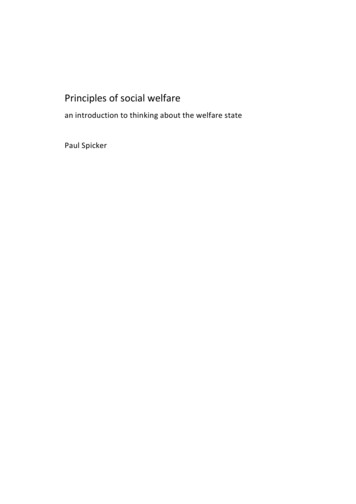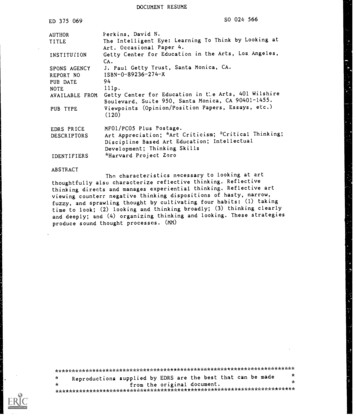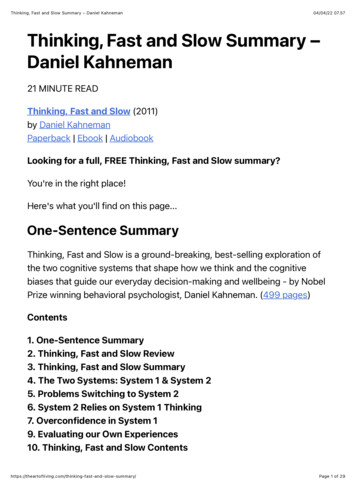
Transcription
Principles of social welfarean introduction to thinking about the welfare statePaul Spicker
First published 1988 by Routledge, ISBN 0-415-00630-9 and 0-415-00631-7 Paul Spicker The author retains the intellectual property.This work is licensed under the Creative Commons Attribution-NonCommercial-NoDerivs3.0 Unported License. You are free to copy, distribute and transmit the work, under thefollowing conditions:!Attribution: you must attribute the work in the manner specified by the author orlicensor (but not in any way that suggests that they endorse you or your use of thework).!Noncommercial: you may not use this work for commercial purposes.!No Derivative Works: you may not alter, transform, or build upon this work.To view a copy of the licence, visit http://creativecommons.org/licenses/by-nc-nd/3.0/ orsend a letter to Creative Commons, 444 Castro Street, Suite 900, Mountain View, California,94041, USA.
Author's note, 2013Principles of social welfare was my second book. The rights to publish have reverted to me,and I am making it freely available on the internet.The book was submitted for publication in 1986, and published in 1988. I think itreads well for its age. Theory does not date rapidly; most of the arguments are still worthconsidering. (I still sometimes refer students to Benn and Peters, Social principles and thedemocratic state, published in 1959.) While there is much else to be said on the subjectscovered, I think they can still be useful as an introduction to normative theory in socialpolicy. However, there are references here that will seem dated. When it was published,Russia was still the Soviet Union, Germany was divided, and in Britain the Thatchergovernment was in power. The agenda of social policy has changed, too.I have not attempted to update the argument or the material. In my later work, Ihave returned to several of the themes examined here, and in almost every case I havecome to think about the issues differently. Freedom, equality and altruism are discussed indifferent terms in Liberty, Equality, Fraternity (Policy Press, 2006). (The differences areconsiderable: for example, there are 5000 words on freedom here, and 25,000 in the laterbook.) I reviewed welfare, individualism and collectivism and the role of the state inReclaming individualism (Policy Press, 2013). I offered a different view of social norms andthe state in The welfare state: a general theory (Sage, 2000). Ideologies and power arediscussed in M Mullard, P Spicker, Social Policy in a changing society, Routledge 1998.Rights and democracy have been discussed in different articles. Possibly more important, Icame through my contact with European ideas to appreciate a range of arguments forsolidarity, diversity and difference. It should be clear, then, that there is very little left inthis book that I would still argue in the same way.The book presented here is much the same as the 1988 edition, with two maindifferences. The first is that this version is somewhat closer to the manuscript that Ioriginally submitted. The book suffered badly at the hands of an over-enthusiastic subeditor, who not only changed much of what I had written but also (to my astonishment)moved the position of all the references, so that some of the things I said were attributed toothers, and some of the things said by others were not properly attributed. All mycorrections - there were hundreds - were over-ruled by the publisher, who said it wouldcost too much to change back. The printed book subsequently appeared with a shorterratum slip that barely conveyed the full horror: for example, that “The author’s originalreferencing has been altered in accordance with Routledge’s house style”. (Kay Jonesappeared as 'Jones and his colleagues'. I sent her a personal note of apology; she was veryunderstanding.) I learned a hard lesson from the experience; I have insisted, for all mysubsequent books, that I should have control of the final copy.The second change is that one of the chapters seemed to me to be too dated to beuseful. In the discussion of inequality, I made the mistake of focusing too strongly oncontemporary information on Britain, which is no longer appropriate. I have left it out, andaltered the later chapter numbers.Bearing in mind the nature of Internet circulation, I also made some other smallalterations in cases where the terminology used in the 1980s is not now consideredappropriate.Paul Spicker
Foreword (from the 1988 edition)This book is about social policy and administration, which is a field of study mainlyconcerned with 'social welfare' and the 'social services'. Social policy is not a self-containedacademic discipline. The book attempts to draw material together and to offer insights intoa set of problems from a variety of perspectives. The source material has been taken frompolitics, sociology, philosophy and economics, as well as from the literature on social policyin its own right; there are occasional references to work from history, psychology,anthropology or law. But it is not possible to deal with each topic in depth in a way thatwould satisfy the demands of each discipline, and usually it is not even desirable. In itsoriginal form, the material may have been only obliquely relevant to social policy; the pointthat is of interest is how it reflects on the issues in the study of social welfare. For that veryreason, the book should be of some value to people who approach it from variousdisciplines. It will not give them a comprehensive statement of the debate in their ownsubject, but it should offer an insight into other areas of study which can be applied to theirown particular interests, and a range of illustrations from the field of social welfare.The book discusses social policy in conceptual terms; it is analytical rather thanprescriptive. Many of the books which have been written on social policy from a theoreticalperspective concentrate on issues of political ideology, packaging the ideas together interms of 'left' and 'right', or recognisable 'isms'. (Examples of this approach can be found inGeorge and Wilding, 1977; Room, 1979; Taylor-Gooby and Dale, 1981; Mishra, 1981; Forderet al., 1984; or Open University, 1985). There is a great deal in this approach which isworthwhile, but for reasons which I explain in the final chapter, the basic method is notadequate to understand the concepts and values applied to welfare. This book is different.It focuses on principles as discrete elements in the formation of social policy. The conceptsit deals with are interrelated in fact, both because ideas like norms and altruism, rights andfreedom, or democracy and the state inform and reinforce each other, and because thepractical examples often raise many issues besides the ones immediately under discussion.However, to make things clearer, the ideas are presented as if they were fairly distinct fromeach other. At each stage, examples are given which are intended to demonstrate theapplication of the arguments to problems in social policy. I hope the result will be anessential complement to the standard texts on the subject.I should like to thank a number of people for their comments on drafts of the text: BobGoodin, Brian Baxter, my colleagues Graham Bowpitt, Val Bean, Richard Marquiss, and NickTilley, and students Maureen Johnson, Ingrid Brown, Sue Ryder, Robert Parker, SandraMaclean and Dominique Chauwin.Paul SpickerTrent Polytechnic
ContentsPart 1: Individual and social welfareChapter 1: WelfareIndividual welfareNeeds and wantsSocial welfareThe common goodWelfare in societyChapter 2: Social normsPolicies for womenMoral rejectionChapter 3: Altruism, exchange and stigmaReciprocityStigmaChapter 4: FreedomIndividual and social concepts of freedomSelf-determination in social workPaternalismChapter 5: RightsThe basis of rightsChildren's rightsRights and citizenshipWelfare rightsPart 2: The Welfare StateChapter 6: Social services and the welfare stateThe nature of a social serviceThe welfare stateWelfare statesThe state and welfareThe social division of welfareChapter 7: DemocracyDemocracy and self-determinationDemocracy and welfareChapter 8: PowerMarxist analysesSocial class and social 484849505354576062636568
Chapter 9: EqualityPositive discriminationChapter 10: Social justiceJustice and propertyJustice and disabilityChapter 11: Structural policyThe nature of social changeStrategies for changePart 3: ConclusionChapter 12: Ideologies of welfareIdeology and welfareReferences717477788083848589909398
Part 1Individual and social welfare
Chapter 1WelfareSummary. Welfare provision serves mainly the physical and material interests of recipients.Interests are linked both with people's needs, which are socially defined, and with whatpeople want. If people can be mistaken about where their interests lie, their welfare willnot be served by considering their wants alone.Social welfare is not simply the sum of individual welfares, and one concept cannotbe derived from the other. Some interests may be held in common. Equally, however,there may be conflicts between interests, and some may bear costs for the benefit ofothers.In its broadest sense, the idea of 'welfare' refers to 'well-being', or what is 'good' for people.Understood more narrowly, it can be taken to refer to the provision of social services principally health care, housing, social security, education and social work. The connectionbetween the two uses rests in the role of social services as 'the provision of welfare'. Partof the purpose of social services is, ideally, altruistic - 'doing good' to people. There arecurative approaches: people who have something wrong with them receive 'treatment' toput it right. Social services can be developmental: a society in which individuals are valuedshould have the facilities to help them realise their potential. And social services mayprotect people; the 'safety net' which the services provide help to remove the uncertaintyassociated with need, a protection against for example the problems of old age, disability orpoverty.However, the provision of welfare is not necessarily for the benefit of the recipientsalone. Townsend suggests that'social services are those means developed and institutionalised by society topromote ends which are wholly or primarily social'. (1976, p.28)In many ways, measures which benefit the individual person are important for society:societies are, after all, made up of people. But there are also aims which can be seen asmore for the benefit of the whole society than for any person within it. The social servicescan, for example, reinforce economic policy. They can be seen as a way to achieve equalityor social justice. They may be an instrument of social change. They can also, conversely, bea means of maintaining social order.The provision of welfare is contentious. There are many different and conflictingviews of what is good for the individual or society. This book is an examination of theprinciples which guide such judgments. Its aim is to explain the values which are beingapplied, to examine the grounds on which disagreements of principle arise, and to relateprinciples to practical issues of welfare provision.Individual welfareWe refer to what is 'good' for people as being in their interests - interests being those thingswhich lead to well-being. Feinberg uses the term 'welfare interests' to refer to the intereststhat he considers fundamental. They include physical health and vigour; physical integrityand functioning; the absence of pain or disfigurement; a minimum degree of intellectualactivity; emotional stability; the absence of groundless anxieties and resentments;engagement in a normal social life; a minimum amount of wealth, income and financialsecurity; a tolerable social and physical environment; and some freedom from interference
by others. (1980, p.32) These interests are 'basic', in his view, because without them aperson cannot be a person. In other words, welfare interests are needs - items that areessential.Maslow (1943) writes, as a psychologist, about a 'hierarchy' of needs, a series ofconditions which must be met for each person.'There are at least five sets of goals which we may call basic needs. These are brieflyphysiological, safety, love, esteem and self-actualisation. . These basic goals arerelated to one another, being arranged in a hierarchy of prepotency. This meansthat the most prepotent goal will monopolise consciousness . The less prepotentneeds are minimised, even forgotten or denied. But when a need is fairly wellsatisfied, the next prepotent (higher) need emerges . ' (1943, p.395)In other words, physiological needs are more important than safety, safety than the needfor love, and so on. There are three main problems with this concept. In the first place,Maslow's order of priority is very arguable - is love really subordinate to safety? Secondly, itis not clear that basic needs can be ordered in a 'hierarchy' at all. In some cases, the valueof measures to look after a person's physiological needs is clearly reduced if other needs arenot met; many people would prefer to be malnourished and free rather than to be well-fedin prison. This implies that people are affected, not so much by a hierarchy, as by a wholeset of interdependent needs. Thirdly, it is difficult to apply the approach directly to theprovision of welfare. Education is almost certainly of less importance than a person'semotional needs, but education is largely organised as a social service, and provision foremotional needs is not. If there is a pressing need for state-run computer dating, the casehas not been made out. On the face of it, the concept of 'welfare' seems to take in everyaspect of a person's life - physical, emotional, material and spiritual. Robson, writing aboutthe 'welfare state', emphasises that 'welfare is of unlimited scope'. (1976, p.174) But inpractice, the concept is rather more limited than a general concern with 'well-being' wouldsuggest. In the context of social policy, the idea of 'welfare' refers primarily to physical andmaterial well-being - not because the areas of emotional and spiritual life are irrelevant, butbecause it is normally considered to be beyond the scope of the social services to providefor them.The sorts of areas in which 'needs' are commonly taken to occur include, Harveysuggests, food, housing, medical care, education, social and environmental service,consumer goods, recreational opportunities, neighbourhood amenities and transportfacilities (1973, p.102). The exclusion of employment opportunities from this list is, Jones etal. note, an illustration of the way in which ideas of need change over time. (1978, p.28) Itis fairly easy to add other needs to the list: they might include physical care (like help inbathing or dressing), clothing, fuel, or simply the money to buy things. But the list is notinfinite; to a large extent, it is limited to those areas in which some sort of social provisionmight be made. The statement that people are in 'need', that they must have something,effectively constitutes a claim against other people to make some sort of response.Within each category of need, there are degrees of classification - 'greater' or 'lesser'needs - depending on how strong the claim is and how 'essential' the need appears to be.An example of this is poverty, the lack of material resources. People are not simply said tobe 'poor' or 'not poor'; they may be destitute (almost totally without resources), poor,deprived, or disadvantaged. Within these categories, there are further gradations - like'very poor', 'poor', 'fairly' poor. These are not precise terms with a universally agreedmeaning, and they may overlap with the other categories; there is no clear distinction, forexample, between 'fairly poor' and 'deprived'. In the case of other 'needs', there aregradations made between those things which are needed more and those which areneeded less. This may mean either that both things are necessary, but one is moreimportant than the other; or that a condition has only been partially satisfied. People ingeneral need food to live, and to be healthy; the food might be enough to preserve life butnot health. A person without any food at all is more 'in need' than someone who does nothave food which is adequately nutritious, but it makes perfectly good sense to talk aboutboth people as being 'in need' - which means that both people have a claim, even if oneclaim is stronger than the other.
Bradshaw (1972) distinguishes two different types of need, normative andcomparative, which represent claims of different types. Normative need is established byexperts, as a fixed level; comparative need is based on a comparison with others. Povertyagain provides a clear example. It is usually separated into two main concepts, absoluteand relative. Absolute poverty describes a minimum standard needed to live, or'subsistence'. Charles Booth, in his studies of Victorian England, identified the main basicneeds as food, clothing, fuel and shelter, and treated people as 'poor' when they lackedenough money to satisfy these needs. Seebohm Rowntree's work later distinguishedprimary poverty, where people have less than is necessary for subsistence, from secondarypoverty, where they fall below the subsistence level because of the way in which theyspend their money. (His purpose in doing this was not to show how badly the poormanaged their money; he was trying to counter the argument that people were poorbecause of mismanagement. His survey showed that even if people managed their budgetperfectly, allowed themselves no luxuries and walked everywhere, many people would stillbe in primary poverty: see Veit Wilson, 1983.) Both of these studies depend on the viewthat poverty can be clearly and explicitly defined in terms of minimum needs.Relative poverty is based on a comparison of poor people with others in society. Aperson who would be considered 'poor' in Britain might be 'well off' in the terms of theThird World. Different standards are being applied, based on comparisons within societiesrather than between them. This definition, however, confuses two different ideas. The firstis that people are poor by comparison with others - for example, because their income is inthe lowest ten per cent of the population, or because they fall significantly below theaverage income. The second idea is drawn from the Marxist tradition. Marx argued thatalthough some human needs are basic to everyone, the pattern and interpretation of thoseneeds is socially defined. (1844, pp. 87-96) This may still mean that a level can be fixed inthe context of a particular society, based on accepted standards rather than oncomparisons between groups. 'Homelessness', for example, is a socially determined issue.In many countries, people without a home of their own build squatter shacks; it is a normalpattern of development in some Third World countries (see Turner, 1969). In Britain,people are not allowed to build a home where or how they can, and the problem ofhomelessness is an obvious result. (This is not to say that squatter settlements are a betterway of dealing with the lack of shelter; they present a different kind of problem.) Poverty,in the same way, is a defined by the conditions prevalent in a particular society. In theUSSR, the official standard of poverty is based in a 'subsistence' standard. This is justified bythe argument that the amount needed for subsistence is determined by the conditions inthat country. (McAuley, 1977) Peter Townsend describes poverty as'the absence or inadequacy of those diets, amenities, standards, services andactivities which are common or customary in society. People are deprived of theconditions of life which customarily define membership of society.' (1979, p.915)This is a complex idea: it combines the Marxist view with a comparative standard, based onobjective circumstances, and the idea of 'relative deprivation', which is based in attitudes.It has been influential in the study of social policy, but it is not uncontentious. It is robustlyrejected by Joseph (a former Conservative Secretary of State responsible for Health andSocial Security) and Sumption:'A family is poor if it cannot afford to eat. It is not poor if it cannot afford endlesssmokes and it does not become poor by the mere fact that other people can affordthem.' (1979, p.27)There are two main problems with Townsend's definition. In the first place, virtuallyeveryone in a society may be poor, in the sense of lacking material resources, but theycould not be considered poor if standards are defined in terms of what is 'common' or'customary'. Marshall writes about 'relative poverty' that:'If it means that poverty is relative to the standard of civilisation of the countryconcerned, it is beyond dispute. If it means that I may not say that A is poor, but
only that he is poorer than B, I cannot accept it.' (1981, pp.116-117)The other main objection to his approach is that it extends the idea of 'poverty' to coveralmost all forms of disadvantage, which is not the way that 'poverty' is generally seen.Poverty refers to the most serious deprivation: T H Marshall argues that 'the common factorin the state of the poor is the urgency of their need'. (1981, p.117) Townsend's extension ofthe term is an attempt to emphasise the claims of all those who are deprived; in doing so,he may be weakening the claim of those whose deprivation is worst.Needs and wantsBradshaw (1972) distinguishes two other categories of need: felt need and expressed need.The terms are fairly self-explanatory; felt need is what people feel they must have, andexpressed need is a strongly expressed want. The distinction between them is that a personcan feel a need without telling other people about it - people are sometimes reluctant toclaim services because of fear, apprehension or stigma - and it is possible to express a needwithout feeling it. Unlike normative and comparative concepts of need, these categoriesare formed by the people in need themselves.Interests can be categorised in a similar way: they can be decided by the person whohas them, or by others who apply different standards to the circumstances of the individual.Little, in a critique of welfare economics, identifies welfare with 'happiness' (1957, ch.5).'Happiness' is a mental state or point of view. It is a value-laden term, because it suggeststhat individual feelings are important; one might argue that only an individual can really tellif he or she is happy, and it seems to follow that individuals are likely to be the best judge oftheir own welfare. 'Welfare' seems, on this basis, to be closely linked to individual choicesand desires. Dahl (1961), a political scientist firmly committed to the American model ofdemocracy, argues that interests can only be identified by the people who have them,which tends to identify interests directly with wants. However, what people want or chooseis not always something that is good for them. People can make the wrong choices; theymay be better off if they are steered in another direction. Barry (1965) links interests withthose things which lead to the satisfaction of wants. It is not necessarily in a child'sinterests to stay off school, even if the child wants to play instead, because ultimatelyschooling increases one's opportunities for wants to be satisfied.There is certainly a link between the satisfaction of wants and a person's welfare.But if people can be mistaken about where their interests lie, their welfare will not beserved by considering their wants alone. Jordan suggests that a person's interests are bestdefined by reference to that person's 'life-plan' (1987b, pp.18-19) - which covers, not onlywhat people currently want, but what they are likely to want in the future. Interests may,then, overlap with expressed desires, but they might not; the two concepts are distinct.Goodin (1982, ch.3) argues that opinion is shaped by experience, and that values andperceptions of interests change constantly. If popular opinion had been the test, it isdoubtful whether there would be any Social Security system in the United States, and if it istaken as the test in the future there may never be a National Health Service there. Hedescribes the emphasis on what people want as 'myopic'. (p.42)Giddens points to interests as implying the satisfaction of 'unconscious' wants.'Since men are not necessarily aware of their motives for acting in a particular way,they are not necessarily aware of what in any given situation their given interests areeither.' (1976, p.86)This moves towards the view that interests are not directly observable, but have to beanalysed. Everyone really 'wants' what is best for them. Unconscious wants - the wantsthey may not realise they have - are the wants they should have if they knew the likelyconsequences. The danger in this approach is fairly clear; it effectively justifies theimposition of one assessment of interests over another. It could be argued that whatpeople happen to want is less important than what is in their interests; but in pretendingthat people want things without realising it, the formula tries to have it both ways,accepting that what people want is important while rejecting what they say. Marx goes a
step further, by saying that capitalist society creates 'false' needs which mislead people asto where their true interests lie (Heller, 1976). This is tantamount to saying that whatpeople think they want is irrelevant.Barry (1965, pp.187-188) refers to principles which respect what people express asin their interests as want-regarding. Other principles, taking other values into account, areideal-regarding - a classification which includes Giddens' 'unconscious' interests. Welfare,Barry argues, takes into account both what people want and what is good for them. It isnecessarily, then, a mixture of want-regarding and ideal-regarding principles. This is areasonable enough position, but it does not help us come to any firm conclusion aboutexactly what 'welfare' might be in a particular case. What it does, instead, is to mark out anarea of uncertainty - an area in which one cannot say with absolute confidence that ameasure does make someone 'better off'.Social welfareThe discussion of 'need' and 'welfare' so far has been based on people as 'individuals'. Oneview of 'society' is that it consists simply of many individuals; 'social welfare', therefore, isnothing but the sum of individual welfares. Oakeshott (1975, p.340), a conservativepolitical philosopher, condemns the idea of society as an abstraction; it implies, he argues,some association between people without specifying what the association is. JeremyBentham, who historically must be considered one of the most important writers onwelfare issues, argued that'The community is a fictitious body, composed of the individual persons who areconsidered as constituting as it were its members. The interest of the community is,then, what? - the sum of the interests of the several members who compose it.'(1789, p.35)This view is basic to traditional welfare economics. Sugden points to three principal valuejudgments (1980, p.166).!!!Each person is on the face of it the best judge of his or her own welfare.Social welfare depends on the welfare of individuals; there is no such thing asthe welfare of a society, through for example its culture or collectiveexistence, which is not directly attributable to the welfare of individuals.If one person's welfare increases, and no-one else's decreases, there hasbeen an increase in social welfare. (This last point is contentious, because itcould mean that increased inequality is acceptable if it does not make othersworse off. The issues are discussed further in chapters 8 and 9.)There are, however, few measures of social welfare provision which leave absolutely no-oneworse off - if only because someone, somewhere has to pay for them. The main exceptionsare measures which increase both efficiency and effectiveness. Efficiency depends on therelationship between aims and costs; the most efficient measure is the one that yields thebest result at least cost, but the constraint of cost means that something less than themaximum goal may be achieved. Effectiveness depends on maximising the achievement ofgoals. Efficiency and effectiveness are sometimes elevated to the status of principles,because they are the means to increase welfare; but in fact they are secondary to otherprinciples, because their importance derives from the aims they are serving.In social planning, cost benefit analysis (CBA) has become an important tool. CBAtries to measure all the costs of a policy or programme against all the benefits which comeout of it. The great advantage of CBA, and the reason for its increasing use, is that it helpsat least to make explicit the likely consequences of certain policy decisions. An example isthe case of child-proofed drug containers, estimated in the early 1970's to cost half a millionpounds each year. The government at first thought the cost was too high, but werepersuaded to meet it when it was argued they would save some sixteen thousandadmissions to hospital and perhaps twenty deaths each year. This is an example of a moreefficient way to avoid problems which are detrimental to welfare - though the fact the
calculation had to be made raises questions about the apparent value placed on a child'slife.Another illustration of CBA in practice is the decision to place crash barriers onmotorways. The effect of these barriers is to reduce the number of fatal accidents, becausecars are less likely to collide with traffic coming in the opposite direction, but to increase thenumber of accidents which are not fatal. In effect, the risks - and the costs borne - arebeing redistributed on the basis of the re
This book is about social policy and administration, which is a field of study mainly concerned with 'social welfare' and the 'social services'. Social policy is not a self-contained academic discipline. The book attempts to draw material together and to offer insights into a set of problems from a variety of perspectives. The source material .











